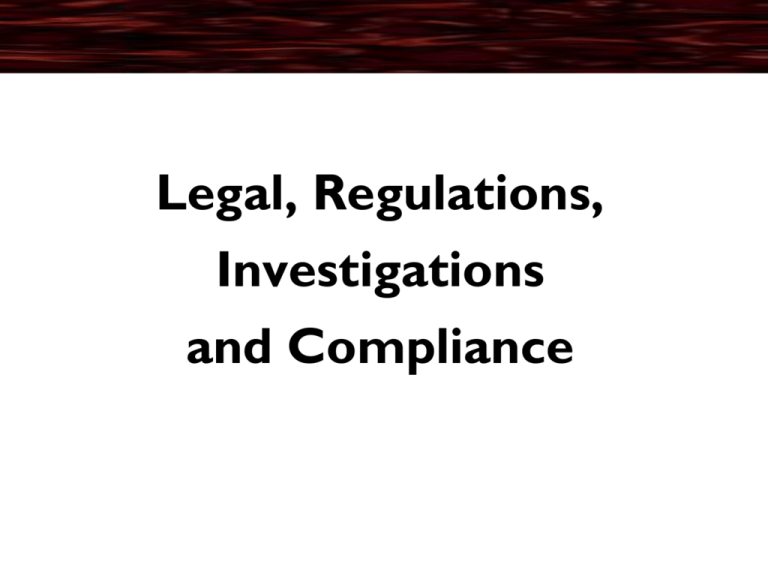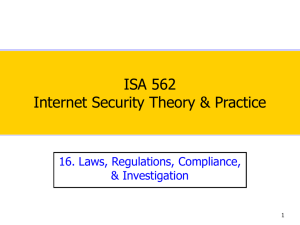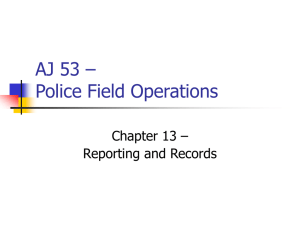Incident Response
advertisement

Legal, Regulations, Investigations and Compliance Domain Objectives • Discuss the world’s various major legal systems • Describe the differences and similarities between common law and civil law • Explain laws and regulations affecting information technology • Discuss computer related crime and its importance to information assurance and security 2 Domain Objectives • Describe the importance of international cooperation in relation to computer crime • Explain an incident response methodology • Discuss the importance of digital evidence management and handling • Describe general guidelines for computer forensic investigations 3 Information Security TRIAD Availability Information Security Integrity Confidentiality 4 Domain Agenda • Major Legal Systems • Information Technology Laws and Regulations • Incident Response • Computer Forensics 5 Major Legal Systems • Common Law • Civil Law • Customary Law • Religious Law • Mixed Law 6 Common Law • Roots in England • Based on Legal Precedents, Past Decisions, and Societal Traditions 7 Common Law • Overview of Common Law • Courts • Judges • Common Law Countries 8 Common Law: Criminal Law • Based on common law, statutory law, or a combination of both • Deals with behavior or conduct • Typically the punishment meted out by the criminal courts involves some loss of personal freedom for the guilty party 9 Common Law: Tort Law • Definition • Punishment • Traces its origin to criminal law 10 Common Law: Tort Law • Principles of a Tort • Categories of a Tort 11 Common Law: Administrative Law • Law created by administrative agencies by way of rules, regulations, orders, and decisions • Areas covered by Administrative Law 12 Civil Law • Traces its roots back to two beginnings: • Roman Empire • Napoleonic Code of France • Characteristics • Presents various sub-divisions • Common law as opposed to Civil law • Methodological approach difference • Judges’ role difference 13 Customary Law • Regionalized systems • Reflects the society’s norms and values • Most countries combine customary law with another legal system 14 Religious Law • Traditional Islamic law (Sharia) • Guided by the Qur’an or Sunnah • Covers all aspects of a person’s life 15 Mixed Law • Convergence of two or more legal systems • Examples of mixed law 16 World Legal Systems Source: WorldLegalSystems 17 Domain Agenda • Major Legal Systems • Information Technology Laws and Regulations • Incident Response • Computer Forensics 18 Information Technology Law & Regulations • Intellectual Property Law • Patent • Trademark • Copyright • Trade Secret • Licensing Issues • Privacy • Liability • Computer Crime • International Cooperation 19 Intellectual Property Laws • Purpose • Two categories • Industrial Property • Copyright 20 Intellectual Property: Patent • Definition • Advantages 21 Intellectual Property: Trademark • Characteristics of a Trademark • Word • Name • Symbol • Color • Sound • Product shape ™ • Purpose of a Trademark 22 Intellectual Property: Copyright • Covers the expression of ideas • Writings • Recordings • Computer programs © • Weaker than patent protection 23 Intellectual Property: Trade Secret • Should be confidential • Protection of Trade Secret 24 Intellectual Property: Software Licensing Issues • Categories of software licensing: • • • • Freeware Shareware Commercial Academic • Master agreements and end user licensing agreements (EULAs) 25 Privacy Laws and Regulations • Rights and Obligations • Individuals • Organizations 26 Privacy Initiatives • Generic Approach • Regulation by Industry • The overall objective is to: • Protect citizen’s personal information • Balance the business and governmental need to collect and use this information 27 Privacy and the OECD • The Organization for Economic Co-operation and Development (OECD) • 7 core principles 28 Employee Privacy • Employee Monitoring • Authorized Usage Policies • Internet usage • Email • Telephone (i.e., VoIP) 29 Privacy: Personal Protection • Responsibilities of end users • Encourage use of: • Encryption • Anti-virus • Patches • Shredding 30 Liability • Legal Responsibility • Penalties • Civil • Criminal Penalties • Negligence is often used to establish liability 31 Negligence • Acting without care • Due care 32 Due Diligence • Ethereal concept often judged against a continually moving benchmark • Requires a commitment to an ongoing risk analysis and risk management process • Due Care vs. Due Diligence 33 Computer Crimes • Often divided into 3 categories • Computers as a Tool • Computers as the Target of Crime • Computer Incidental to the Crime 34 Computer Crimes • Insider abuse • Stalking • Viruses • Organized crime • White collar/Financial fraud • Terrorism • Corporate espionage • Hacking • Identity Theft • Social Engineering • Child Pornography 35 International Cooperation • Initiatives related to International Cooperation in dealing with Computer Crime • The Council of Europe (CoE) Cybercrime Convention 36 Domain Agenda • Major Legal Systems • Information Technology Laws and Regulations • Incident Response • Computer Forensics 37 Incident Response: Overview • Response capability • Policy and guidelines • Response • Incident response • • • • • • Debriefing • Metrics • Public Disclosure Triage Containment Investigation Analysis and Treatment Recovery 38 Incident Response Objectives • Incident response in its simplest form is the practice of: • • • • • Detecting a problem Determining its cause Minimizing the damage it causes Resolving the problem Documenting each step of the response for future reference 39 Response Capability • The foundation for Incident Response (IR) is comprised of: • • • • Policy Procedures Guidelines Management of evidence 40 Incident Response Policy • Escalation Process • Interaction with third party entities 41 Response Team • Staffing and training • Virtual Team • Permanent Team • Hybrid of the Virtual and Permanent • Response Team Members 42 Incident Response and Handling • Incident • Approved Handling Process 43 Incident Response and Handling Phases • Triage • Investigation • Containment • Analysis and tracking 44 Triage • Triage encompasses: • Detection • Classification • Notification 45 Triage - Detection • Initial Screening • False Positives 46 Triage - Classification • Incident Hierarchy • General Classifiers • Source (internal vs. external) • More Granular or Specific Characteristics • (i.e., worm vs. spam) 47 Investigation Phase Components • Components of this phase: • • • • Analysis Interpretation Reaction Recovery 48 Investigation Phase Objectives • Desired outcomes of this phase are: • Reduce the impact • Identify the cause • Get back up and running in the shortest possible time • Prevent the incident from re-occurring 49 Investigation Considerations • The investigative phase must consider: • Adherence to company policy • Applicable laws and regulations • Proper evidence management and handling 50 Containment • Reduce the potential impact of the incident • Systems, devices, or networks that can become “infected” • The containment strategy depends on: • Category of the attack • Asset(s) affected • Criticality of the data or system 51 Containment Strategies • Disconnecting the system from the network • Virtually isolating the systems through network segmentation • Implementing a firewall or filtering router with the appropriate rule sets • Installation of Honeynets/Honeypots 52 Containment Documentation • Incident and evidence handling procedures • Sources of evidence • Risk of Entrapment vs. Enticement 53 Analysis and Tracking • The Concept of Root Cause • Determines actual initial event • Attempts to identify the true source and actual point of entry 54 Analysis and Tracking Goals • Obtain sufficient information to stop the current incident • Prevent future “like” incidents from occurring • Identify what or whom is responsible 55 Analysis and Tracking Team • Heterogeneous and/or Eclectic Skills • Solid understanding of the systems affected • Real World, Applied Experience 56 Analysis and Tracking Logs • Dynamic Nature of the Logs • Feeds into the tracking process • Working Relationship with other Entities 57 Recovery Phase Goal • To get back up and running • The Business (worst case) • Affected Systems (best case) • Protect evidence 58 Recovery and Repair • Recovery into production of affected systems • Ensure system can withstand another attack • Test for vulnerabilities and weaknesses 59 Closure of the Incident • Incident response is an iterative process • Closure to the incident 60 Debriefing/Feedback • Formal process • Include all of the team members • Use output to adapt or modify policy and guidelines 61 Communications of the Incident • Public disclosure of an incident can: • Compound the negative impact • Provide an opportunity regain public trust • Communication handled by authorized personnel only 62 Domain Agenda • Major Legal Systems • Information Technology Laws and Regulations • Incident Response • Computer Forensics 63 Computer Forensics • Key Components • Crime scenes • Digital evidence • Guidelines 64 Computer Forensics: The Law • The inclusion of the “law”, introduces concepts that may be foreign to many information security professionals • • • • • Crime scene Chain of custody Best evidence Admissibility requirements Rules of evidence 65 Computer Forensics: Evidence • Computer Forensics includes: • Evidence or potential evidence • Falls under the larger domain of Digital Forensic Science Research Workshop • Deals with evidence and the legal system 66 Computer Forensics: Evidence • Correctly identifying the crime scene, evidence, and potential containers of evidence • Collecting or acquiring evidence: • Adhering to the criminalistic principles • Keeping contamination and the destruction of the scene to a minimum 67 Computer Forensics: Evidence • Using the scientific methods: • Determine characteristics of the evidence • Comparison of evidence • Event reconstruction • Presentation of findings: • Interpreting and analysis of the examination • Articulating these in a format appropriate for the intended audience 68 Crime Scene • Prior to identifying evidence, the larger crime scene needs to be addressed • A crime scene is nothing more than: • The environment in which potential evidence may exist • Digital crime scenes follow the same principles 69 Crime Scene • The principles of criminalistics apply to both digital and physical crime scenes: • Identify the scene • Protect the environment • Identify evidence and potential sources of evidence • Collect evidence • Minimize the degree of contamination 70 Crime Scene: Physical vs. Virtual • The Crime Scene Environment • Physical • Virtual or Cyber 71 Locard’s Principle • Locard’s Principle of Exchange • When a crime is committed, the Perpetrator • Leaves something behind • Takes something with them • This principle allows us to identify aspects of the person or persons responsible, even with a purely digital crime scene 72 Behavior • Investigation or Root Cause Analysis • Means, Opportunity, and Motives (MOM) • Modus Operandi (MO) • Criminal computer behavior is no different than typical criminal behavior 73 Behavior of Computer Criminals • Computer criminals have specific MO’s • Hacking software/tools • Types of systems or networks attacked, etc. • Signature behaviors • MO & Signature behaviors • Profiling • Interviewing 74 Crime Scene Analysis • Protect the ‘crime scene’ from unauthorized individuals • Once a scene has been contaminated, there is no undo or redo button to push • The damage is done! 75 Digital Evidence • The exact requirements for the admissibility of evidence vary • Evidence 76 Digital Evidence: 5 Rules • Admissible • Authentic • Complete • Accurate • Convincing 77 Digital Evidence: Hearsay • Hearsay • Second-hand evidence • Normally not admissible • Business records exceptions: • Computer generated information can fall into this category • May require someone to attest to the how the records/information were created 78 Digital Evidence: Life Span • Digital evidence • • • • Volatile and “fragile” May have a short “life span” Collect quickly By order of volatility (i.e., most volatile first) • Document, document, document! 79 Digital Evidence: Chain of Custody • Chain of Custody • • • • • Who What When Where How 80 Digital Evidence: Accuracy and Integrity • Ensuring the accuracy and integrity of evidence is critical! • The current protocol for demonstrating accuracy and integrity relies on hash functions • MD5 • SHA 256 81 General Guidelines • IOCE/SWGDE 6 principles for computer forensics and digital/electronic evidence • When dealing with digital evidence, all of the general forensic and procedural principles must be applied • Upon seizing digital evidence, actions taken should not change that evidence • When it is necessary for a person to access original digital evidence, that person should be trained for the purpose 82 Six IOCE/SWGDE Principles • All activity relating to the seizure, access, storage or transfer of digital evidence must be fully documented, preserved and available for review • An Individual is responsible for all actions taken with respect to digital evidence whilst the digital evidence is in their possession • Any agency, which is responsible for seizing, accessing, storing or transferring digital evidence is responsible for compliance with these principles 83 General Guidelines: Dos and Don’ts • Minimize Handling/Corruption of Original Data • Account for Any Changes and Keep Detailed Logs of Your Actions • Comply with the Five Rules for Evidence • Do Not Exceed Your Knowledge • Follow Your Local Security Policy and Obtain Written Permission 84 General Guidelines: Dos and Don’ts • Capture as Accurate an Image of the System as Possible • Be Prepared to Testify • Ensure Your Actions are Repeatable • Work Fast • Proceed From Volatile to Persistent Evidence • Don't Run Any Programs on the Affected System 85 General Guidelines: Dos and Don’ts • Act ethically • In good faith • Attempt to do no harm • Do not exceed one’s knowledge, skills, and abilities 86 Domain Summary • Know local laws and regulations • Have an approved procedure for handling of incidents • Ensure that all handling of sensitive information is compliant with regulation • Follow best practices and document all steps of an investigation 87 “Security Transcends Technology”









